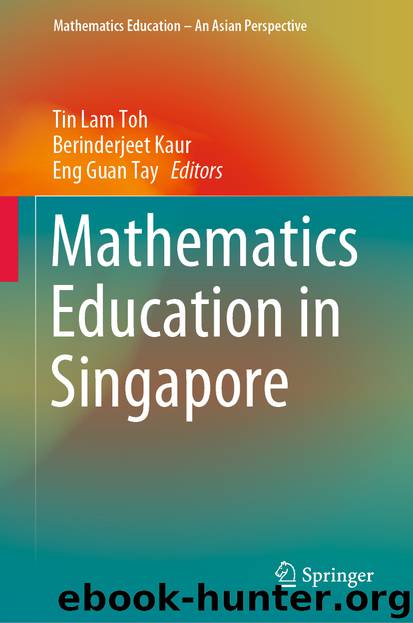Mathematics Education in Singapore by Tin Lam Toh & Berinderjeet Kaur & Eng Guan Tay

Author:Tin Lam Toh & Berinderjeet Kaur & Eng Guan Tay
Language: eng
Format: epub
ISBN: 9789811335730
Publisher: Springer Singapore
11.4 Enactment of Metacognitive Instructional Practices
As was pointed out Sect. 11.2.1, metacognition has been an aspect of the SMCF since 1992. However, despite the fact that metacognition has been a key feature of the SMCF for more than twenty years, there has been limited effort to examine its impact in the mathematics classrooms from both the teaching and learning perspective. Through Singapore’s participation in PISA 2009 (OECD 2010), there were efforts to collect data through student survey data to obtain a profile of our 15-year-old students’ control strategies as a form of metacognitive practice in learning. However, there is also a need for identification and classification of the conceptions of metacognition and metacognitive instructional practices among mathematics teachers—the frontline practitioners who enact the curriculum and principally responsible for the curriculum experienced by the students. The Core 2 Research Programme undertaken by the National Institute of Education (NIE) (Jonid et al. 2014) made a first attempt to determine the level of metacognitive instructional practice employed by teachers in Primary 5 and Secondary 3 mathematics classrooms by analysing the mathematics teachers’ instruction. However, it is extremely difficult to differentiate between cognitive and metacognitive processes (Garofalo and Lester 1985; Perkins et al. 1990; Loh and Lee 2017). The key issue lies with the difficulty to distinguish clearly between what is meta and what is cognition (Brown et al. 1983; Baker 1991; Cheng 1999) and that the interactions between the various mental processes are complex (Yeo 2013; Loh and Lee 2017). In a review of the literature on cognition and metacognition, Tarricone (2011, p. 1) observed that the main distinction between the two is that ‘cognition is a constant flow of information and metacognition is knowledge and awareness of processes and the monitoring and control of such knowledge and processes … metacognition is considered to be second-order cognitions’. Thus the task of accurately coding a teaching act as metacognitive instructional practice without other supporting input to triangulate the data, as in the case by Jonid et al. (2014), may result in an over-generalisation and thus may not accurately portray the current situation in the primary mathematics classroom.
In 2015, MOE awarded a group of mathematics education researchers in NIE a research project (AFR 04/14 LNH) to systematically use a multi-site, multi-case-based approach to collect and triangulate data through survey, classroom observations and interviews to develop preliminary teacher conceptions of metacognition and metacognitive practices grounded based on the phenomenon under observation. Ng et al. (2016) shared the following findings from the project:Teachers’ conception of metacognition is superficial and/or they are confused between cognition and metacognition. Teachers’ description of metacognition may contain elements of metacognition, e.g. awareness, monitoring, regulation, reflection, but there is a lack of precise description; some confused metacognition with other cognitive skills (e.g. critical thinking and creative thinking skills), while others confused it with teaching approaches (e.g. engaged learning).
Download
This site does not store any files on its server. We only index and link to content provided by other sites. Please contact the content providers to delete copyright contents if any and email us, we'll remove relevant links or contents immediately.
| Arts & Humanities | Health |
| Language Arts | Library Skills |
| Mathematics | Reading & Phonics |
| Science & Technology | Social Studies |
The Art of Coaching Workbook by Elena Aguilar(48572)
Trainspotting by Irvine Welsh(20140)
Twilight of the Idols With the Antichrist and Ecce Homo by Friedrich Nietzsche(17754)
Fangirl by Rainbow Rowell(7893)
Periodization Training for Sports by Tudor Bompa(7376)
Change Your Questions, Change Your Life by Marilee Adams(6702)
This Is How You Lose Her by Junot Diaz(5845)
Grit by Angela Duckworth(4777)
Red Sparrow by Jason Matthews(4734)
Asking the Right Questions: A Guide to Critical Thinking by M. Neil Browne & Stuart M. Keeley(4641)
Paper Towns by Green John(4209)
Room 212 by Kate Stewart(4152)
Ken Follett - World without end by Ken Follett(4003)
The Sports Rules Book by Human Kinetics(3630)
Housekeeping by Marilynne Robinson(3455)
The Motorcycle Diaries by Ernesto Che Guevara(3379)
Exercise Technique Manual for Resistance Training by National Strength & Conditioning Association(3329)
Introduction to Kinesiology by Shirl J. Hoffman(3328)
Papillon (English) by Henri Charrière(3323)
